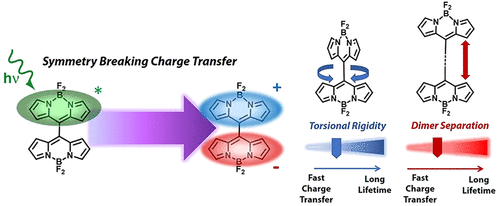当前位置:
X-MOL 学术
›
Acc. Chem. Res.
›
论文详情
Our official English website, www.x-mol.net, welcomes your
feedback! (Note: you will need to create a separate account there.)
Controlling Symmetry Breaking Charge Transfer in BODIPY Pairs
Accounts of Chemical Research ( IF 16.4 ) Pub Date : 2022-05-23 , DOI: 10.1021/acs.accounts.2c00044 Laura Estergreen 1 , Austin R Mencke 1 , Daniel E Cotton 2 , Nadia V Korovina 3 , Josef Michl 3 , Sean T Roberts 2 , Mark E Thompson 1 , Stephen E Bradforth 1
Accounts of Chemical Research ( IF 16.4 ) Pub Date : 2022-05-23 , DOI: 10.1021/acs.accounts.2c00044 Laura Estergreen 1 , Austin R Mencke 1 , Daniel E Cotton 2 , Nadia V Korovina 3 , Josef Michl 3 , Sean T Roberts 2 , Mark E Thompson 1 , Stephen E Bradforth 1
Affiliation

|
Symmetry breaking charge transfer (SBCT) is a process in which a pair of identical chromophores absorb a photon and use its energy to transfer an electron from one chromophore to the other, breaking the symmetry of the chromophore pair. This excited state phenomenon is observed in photosynthetic organisms where it enables efficient formation of separated charges that ultimately catalyze biosynthesis. SBCT has also been proposed as a means for developing photovoltaics and photocatalytic systems that operate with minimal energy loss. It is known that SBCT in both biological and artificial systems is in part made possible by the local environment in which it occurs, which can move to stabilize the asymmetric SBCT state. However, how environmental degrees of freedom act in concert with steric and structural constraints placed on a chromophore pair to dictate its ability to generate long-lived charge pairs via SBCT remain open topics of investigation.
中文翻译:

控制 BODIPY 对中的对称破坏电荷转移
对称破坏电荷转移 (SBCT) 是一个过程,其中一对相同的生色团吸收一个光子并使用其能量将电子从一个生色团转移到另一个生色团,从而打破生色团对的对称性。这种激发态现象在光合生物中观察到,它能够有效地形成最终催化生物合成的分离电荷。SBCT 也被提议作为开发以最小能量损失运行的光伏和光催化系统的手段。众所周知,生物和人工系统中的 SBCT 部分是由其发生的局部环境促成的,该环境可以移动以稳定不对称的 SBCT 状态。然而,
更新日期:2022-05-23
中文翻译:

控制 BODIPY 对中的对称破坏电荷转移
对称破坏电荷转移 (SBCT) 是一个过程,其中一对相同的生色团吸收一个光子并使用其能量将电子从一个生色团转移到另一个生色团,从而打破生色团对的对称性。这种激发态现象在光合生物中观察到,它能够有效地形成最终催化生物合成的分离电荷。SBCT 也被提议作为开发以最小能量损失运行的光伏和光催化系统的手段。众所周知,生物和人工系统中的 SBCT 部分是由其发生的局部环境促成的,该环境可以移动以稳定不对称的 SBCT 状态。然而,











































 京公网安备 11010802027423号
京公网安备 11010802027423号